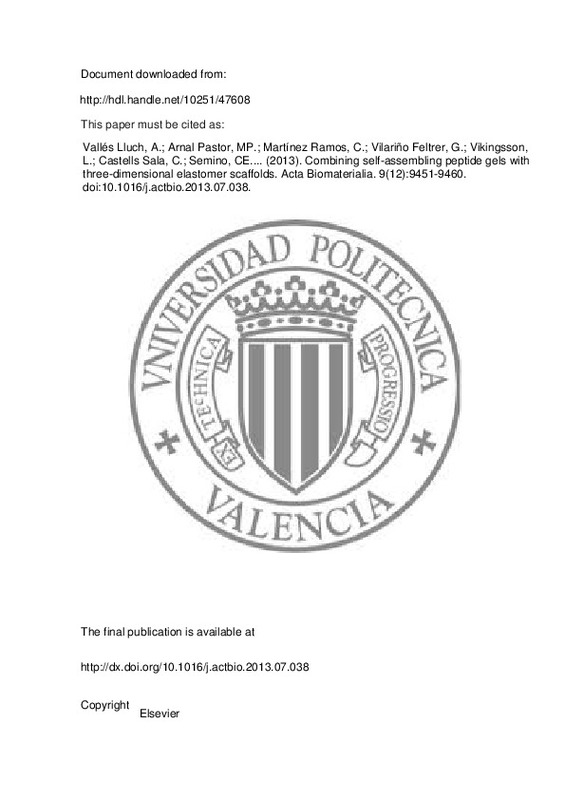JavaScript is disabled for your browser. Some features of this site may not work without it.
Buscar en RiuNet
Listar
Mi cuenta
Estadísticas
Ayuda RiuNet
Admin. UPV
Combining self-assembling peptide gels with three-dimensional elastomer scaffolds
Mostrar el registro sencillo del ítem
Ficheros en el ítem
| dc.contributor.author | Vallés Lluch, Ana
|
es_ES |
| dc.contributor.author | Arnal Pastor, María Pilar
|
es_ES |
| dc.contributor.author | Martínez Ramos, Cristina
|
es_ES |
| dc.contributor.author | Vilariño Feltrer, Guillermo
|
es_ES |
| dc.contributor.author | Vikingsson, Line
|
es_ES |
| dc.contributor.author | Castells Sala, Carla
|
es_ES |
| dc.contributor.author | Semino, Carlos Eduardo
|
es_ES |
| dc.contributor.author | Monleón Pradas, Manuel
|
es_ES |
| dc.date.accessioned | 2015-03-02T12:02:43Z | |
| dc.date.available | 2015-03-02T12:02:43Z | |
| dc.date.issued | 2013-12 | |
| dc.identifier.issn | 1742-7061 | |
| dc.identifier.uri | http://hdl.handle.net/10251/47608 | |
| dc.description.abstract | [EN] Some of the problems raised by the combination of porous scaffolds and self-assembling peptide (SAP) gels as constructs for tissue engineering applications are addressed for the first time. Scaffolds of poly(- ethyl acrylate) and the SAP gel RAD16-I were employed. The in situ gelation of the SAP gel inside the pores of the scaffolds was studied. The scaffold-cum-gel constructs were characterized morphologically, physicochemically and mechanically. The possibility of incorporating an active molecule (bovine serum albumin, taken here as a model molecule for others) in the gel within the scaffold’s pores was assessed, and the kinetics of its release in phosphate-buffered saline was followed. Cell seeding and colonization of these constructs were preliminarily studied with L929 fibroblasts and subsequently checked with sheep adipose-tissue-derived stem cells intended for further preclinical studies. Static (conventional) and dynamically assisted seedings were compared for bare scaffolds and the scaffold-cum-gel constructs. The SAP gel inside the pores of the scaffold significantly improved the uniformity and density of cell colonization of the three-dimensional (3-D) structure. These constructs could be of use in different advanced tissue engineering applications, where, apart from a cell-friendly extracellular matrix -like aqueous environment, a larger-scale 3-D structure able to keep the cells in a specific place, give mechanical support and/or conduct spatially the tissue growth could be required. | es_ES |
| dc.description.sponsorship | The authors acknowledge funding through the European Commission FP7 project RECATABI (NMP3-SL-2009-229239), and from the Spanish Ministerio de Ciencia e Innovacion through projects MAT2011-28791-C03-02 and -03. Dr. J.C. Chachques (Hopital Europeen Georges Pompidou, Paris) is thanked for providing the ASCs employed in this study. MMP acknowledges support of CIBER-BBN initiative, financed by Institut de Salud Carlos III (Spain) with the assistance of the European Regional Development Fund. | en_EN |
| dc.language | Español | es_ES |
| dc.publisher | Elsevier | es_ES |
| dc.relation.ispartof | Acta Biomaterialia | es_ES |
| dc.rights | Reserva de todos los derechos | es_ES |
| dc.subject | Scaffold | es_ES |
| dc.subject | Poly(ethyl acrylate) | es_ES |
| dc.subject | Self-assembling peptide gel | es_ES |
| dc.subject | Controlled release | es_ES |
| dc.subject | Cell seeding | es_ES |
| dc.subject.classification | MAQUINAS Y MOTORES TERMICOS | es_ES |
| dc.subject.classification | TERMODINAMICA APLICADA (UPV) | es_ES |
| dc.title | Combining self-assembling peptide gels with three-dimensional elastomer scaffolds | es_ES |
| dc.type | Artículo | es_ES |
| dc.identifier.doi | 10.1016/j.actbio.2013.07.038 | |
| dc.relation.projectID | info:eu-repo/grantAgreement/MICINN//MAT2011-28791-C03-02/ES/MATERIALES DE SOPORTE Y LIBERACION CONTROLADA PARA LA REGENERACION DE ESTRUCTURAS NEURALES AFECTADAS POR ICTUS/ | es_ES |
| dc.relation.projectID | info:eu-repo/grantAgreement/EC/FP7/229239/EU/Regeneration of Cardiac Tissue Assisted by Bioactive Implants/ | es_ES |
| dc.relation.projectID | info:eu-repo/grantAgreement/MICINN//MAT2011-28791-C03-03/ES/CONSTRUCTOS PARA LA REGENERACION GUIADA DE ESTRUCTURAS DEL SISTEMA NERVIOSO CENTRAL/ | es_ES |
| dc.rights.accessRights | Abierto | es_ES |
| dc.contributor.affiliation | Universitat Politècnica de València. Centro de Biomateriales e Ingeniería Tisular - Centre de Biomaterials i Enginyeria Tissular | es_ES |
| dc.contributor.affiliation | Universitat Politècnica de València. Departamento de Termodinámica Aplicada - Departament de Termodinàmica Aplicada | es_ES |
| dc.description.bibliographicCitation | Vallés Lluch, A.; Arnal Pastor, MP.; Martínez Ramos, C.; Vilariño Feltrer, G.; Vikingsson, L.; Castells Sala, C.; Semino, CE.... (2013). Combining self-assembling peptide gels with three-dimensional elastomer scaffolds. Acta Biomaterialia. 9(12):9451-9460. https://doi.org/10.1016/j.actbio.2013.07.038 | es_ES |
| dc.description.accrualMethod | S | es_ES |
| dc.relation.publisherversion | http://dx.doi.org/10.1016/j.actbio.2013.07.038 | es_ES |
| dc.description.upvformatpinicio | 9451 | es_ES |
| dc.description.upvformatpfin | 9460 | es_ES |
| dc.type.version | info:eu-repo/semantics/publishedVersion | es_ES |
| dc.description.volume | 9 | es_ES |
| dc.description.issue | 12 | es_ES |
| dc.relation.senia | 253419 | |
| dc.identifier.eissn | 1878-7568 | |
| dc.contributor.funder | European Commission | |
| dc.contributor.funder | Ministerio de Ciencia e Innovación | |
| dc.contributor.funder | Instituto de Salud Carlos III |







![[Cerrado]](/themes/UPV/images/candado.png)

